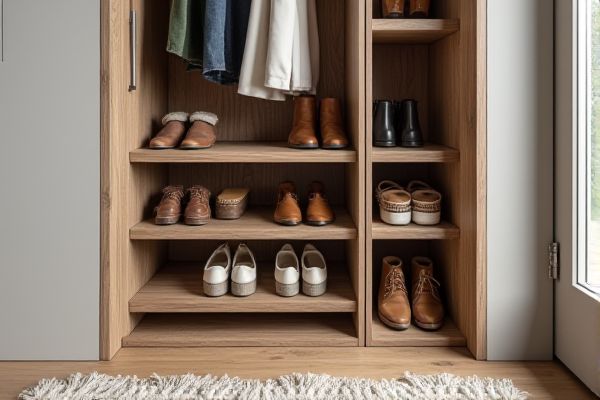
Open shoe racks offer easy access and ventilation, preventing odors and moisture buildup, while enclosed shoe cabinets provide a tidier look and protect shoes from dust and damage. Discover which option best suits Your space and organizational needs by reading the rest of the article.
Table of Comparison
| Feature | Open Shoe Rack | Enclosed Shoe Cabinet |
|---|---|---|
| Design | Open shelves, visible shoes | Closed doors, hidden storage |
| Space Efficiency | Compact, easy to fit in small areas | Typically bulkier but offers more storage options |
| Protection | Exposes shoes to dust and dirt | Protects shoes from dust, moisture, and damage |
| Ventilation | Good ventilation, reduces odor | Limited ventilation unless designed with vents |
| Accessibility | Easy and quick access | Requires opening doors, slightly slower access |
| Maintenance | Easy to clean and maintain | Requires regular cleaning inside to prevent odors |
| Style & Aesthetics | Casual and modern look | Formal and sleek appearance |
Introduction to Shoe Storage Solutions
Open shoe racks offer easy access and ventilation, allowing your shoes to air out and stay fresh while saving space with a minimalist design. Enclosed shoe cabinets provide protection from dust and damage, ideal for organizing larger collections with aesthetics that blend seamlessly into your home decor. Choosing between the two depends on your storage needs, available space, and preference for visibility versus protection.
Overview of Open Shoe Racks
Open shoe racks provide easy access and visibility, making it simple to organize and retrieve your footwear quickly. They promote air circulation, which helps prevent odor and moisture buildup, ideal for maintaining shoe freshness. This design offers a lightweight, budget-friendly solution, perfect for those seeking functionality without bulk.
Overview of Enclosed Shoe Cabinets
Enclosed shoe cabinets provide a dust-free storage solution that protects shoes from dirt and damage, making them ideal for maintaining shoe quality over time. These cabinets typically feature doors or panels that conceal shoes, contributing to a tidier and more organized appearance in entryways or closets. Materials like wood, metal, or engineered composites enhance durability and style, while designs often include adjustable shelves or ventilation to accommodate various shoe types and sizes.
Space Efficiency: Open vs Enclosed
Open shoe racks maximize space efficiency by offering easy access and visibility, allowing you to quickly organize and retrieve shoes without bulk. Enclosed shoe cabinets, while often bulkier due to doors and panels, optimize vertical storage and conceal clutter, making them ideal for maintaining a tidy appearance in smaller or multi-use spaces. Your choice depends on balancing accessibility with space-saving needs in your specific environment.
Organization and Accessibility
Open shoe racks provide easy visibility and quick access, allowing you to effortlessly find and select your footwear, which enhances daily convenience. Enclosed shoe cabinets protect shoes from dust and clutter, promoting a tidier appearance but may require more time to locate specific pairs due to concealed storage. Your choice depends on whether you prioritize immediate accessibility or a cleaner, more organized space.
Protection and Shoe Longevity
Open shoe racks provide easy access and ventilation, preventing moisture buildup that can cause shoe odor and deterioration. Enclosed shoe cabinets offer superior protection against dust, sunlight, and accidental damage, extending your shoes' lifespan by maintaining their condition. Choosing between the two depends on your priority for accessibility versus maximum protection to enhance shoe longevity.
Aesthetic Considerations
Open shoe racks offer a modern, minimalist aesthetic that complements contemporary interiors by showcasing footwear as decorative elements, while enclosed shoe cabinets provide a sleek, streamlined appearance that hides clutter and maintains a clean, organized look. Materials and finishes in enclosed cabinets often enhance room elegance, whereas open racks emphasize accessibility and casual style. Selecting between the two depends on whether the priority is visual openness or a polished, refined decor.
Maintenance and Cleaning
Open shoe racks offer easier maintenance and cleaning due to their exposed design, allowing quick dusting and ventilation that prevents odor buildup. Enclosed shoe cabinets require more effort to clean because dust accumulates inside and in corners, and airflow is restricted, which can trap moisture and cause odors. Choosing between the two depends on the priority for convenience in upkeep versus protection from dust and clutter.
Cost Comparison
Open shoe racks generally cost less than enclosed shoe cabinets due to simpler materials and designs, making them budget-friendly for basic storage needs. Enclosed shoe cabinets often involve higher expenses because of more complex construction, added doors, and finishes that provide dust protection and aesthetics. Consumers looking for affordable options tend to prefer open racks, while those prioritizing durability and style may invest in enclosed cabinets despite the increased cost.
Choosing the Right Option for Your Home
Open shoe racks maximize airflow and visibility, making them ideal for quick access and ventilation, especially in humid climates. Enclosed shoe cabinets provide a cleaner, organized appearance and protect shoes from dust and damage, suitable for homes prioritizing aesthetics and maintenance. Selecting the right option depends on your space constraints, lifestyle needs, and design preferences.
 homyna.com
homyna.com